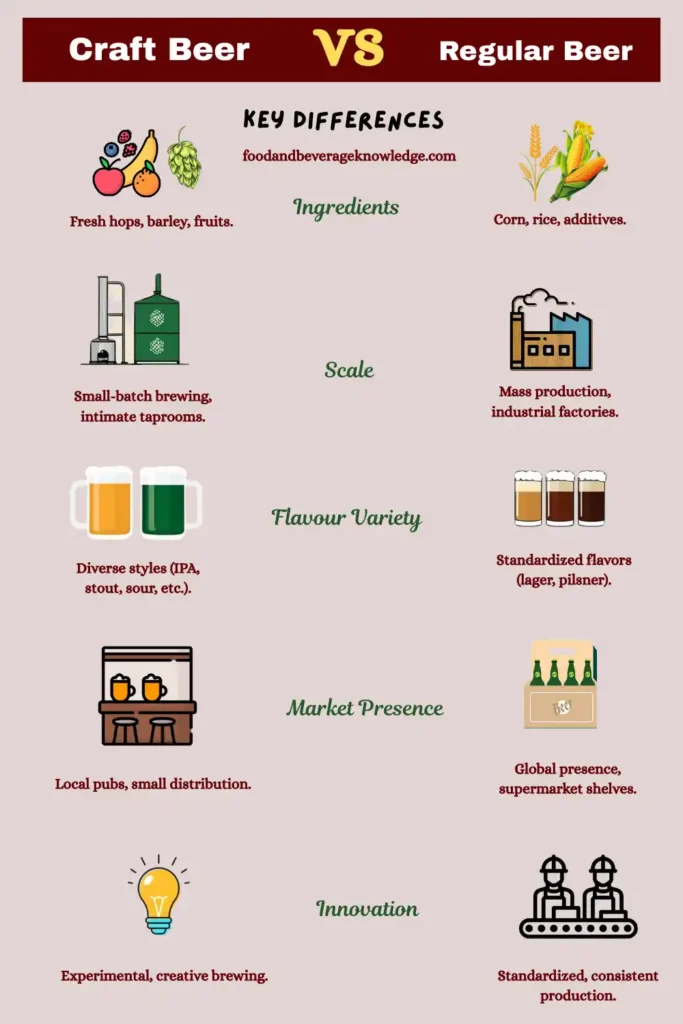The rise of craft beer has transformed the global beer landscape, offering enthusiasts a diverse range of flavours, styles, and experiences that go beyond the familiar taste of mass-produced lagers. Over the past few decades, beer lovers have sought out more than just a cold, refreshing drink—they’ve craved creativity, authenticity, and connection. Enter craft beer: a revolution that has reshaped how we think about beer.
What is craft beer?
At its core, craft beer refers to beer produced by small, independent breweries that emphasise quality, flavour, and traditional or innovative brewing methods. Unlike large-scale commercial beers designed for consistency and mass appeal, craft beers are often experimental, local, and driven by a passion for the craft itself.
This article will explore the essence of craft beer, tracing its roots, defining its characteristics, examining its differences from regular beer, Examples, and exploring its growing global footprint.
For additional background on global perspectives on craft beer, see the Craft beer article on Wikipedia.
Looking for the most popular craft beer styles? This infographic breaks down the key flavours, alcohol content, and characteristics of fan-favourite styles like IPAS, stouts, sours, and Belgian ales. Discover which style suits your taste!”

Defining Craft Beer
According to the Brewers Association, three key criteria define craft beer:
- Small: Craft breweries produce no more than 6 million barrels of beer per year. While this may sound like a lot, it’s minuscule compared to giants like Anheuser-Busch, which produces hundreds of millions of barrels annually.
- Independent: To qualify as a craft brewery, less than 25% of the brewery can be owned or controlled by an alcoholic beverage industry member that is not itself a craft brewer. This ensures that craft breweries maintain their independence and are not influenced by corporate interests.
- Traditional: Craft brewers focus on traditional or innovative brewing techniques, often using malted barley as a key ingredient and eschewing adjuncts like rice or corn used primarily to lighten flavour or reduce cost.
Globally, the definition varies by country, reflecting local regulations, traditions, and industry dynamics. In the UK, for example, the term “real ale” describes traditionally brewed, unfiltered, and unpasteurized beer, which overlaps with but is not identical to the craft beer category.
Also Read: The Ultimate Guide to Draft & Draught Beer: Everything You Need to Know
Historical Evolution of Craft Beer
Craft beer has deep historical roots, stretching back thousands of years to some of humanity’s earliest civilisations.
- Ancient Origins: Evidence suggests that beer brewing began as early as 7000 BCE in ancient China, with similar developments in Mesopotamia and Egypt. These early beers were often part of religious rituals, daily sustenance, or social gatherings. Ingredients varied widely, including barley, wheat, honey, and various fruits.
- European Influence: Europe became the cradle of beer diversity. In Germany, the Reinheitsgebot (beer purity law) of 1516 established strict standards for brewing, while Belgium became famous for its Trappist ales, lambics, and saisons, brewed with wild yeasts and distinctive spices. Britain, too, contributed with styles like porter, stout, and pale ale.
- American Craft Beer Movement: In the U.S., beer production was dominated by large breweries through most of the 20th century, especially following Prohibition. However, the legalisation of homebrewing in 1978 marked a turning point. Homebrewers began experimenting with styles largely absent from the American market, and some of these hobbyists—including pioneers like Anchor Brewing and Sierra Nevada—laid the groundwork for today’s vibrant craft beer scene. Over the ensuing decades, the number of American craft breweries exploded, growing from fewer than 100 in the 1980s to over 9,000 today.
Examples of Craft Beer
To illustrate the variety and creativity of craft beer, here are four notable examples:
- Sierra Nevada Pale Ale (USA): One of the pioneers of the American craft beer movement, this beer is known for its bold hop character, citrusy aroma, and balanced malt backbone.
- Chimay Blue (Belgium): A world-famous Trappist ale, this Belgian strong dark ale offers rich notes of dried fruits, caramel, and spices, crafted by monks with centuries of brewing tradition.
- Hitachino Nest White Ale (Japan): A unique wheat beer brewed with coriander, orange peel, and nutmeg, showcasing Japan’s blend of craft innovation and precision.
- BrewDog Punk IPA (Scotland): A flagship IPA from one of Europe’s most recognised craft breweries, delivering tropical fruit flavours, sharp bitterness, and rebellious branding.
Characteristics of Craft Beer
Craft beer is defined as much by its spirit as by its ingredients or production methods. Several characteristics set craft beer apart:
- Flavour and Innovation: Craft brewers often push boundaries, incorporating local fruits, spices, herbs, coffee, chocolate, and even unusual grains. They experiment with fermentation techniques and ageing processes. This results in a wide range of styles, from hop-forward IPAS to rich stouts and tart sours.
- Production Scale: Small-batch brewing allows craft brewers to pay close attention to quality. It gives them freedom to innovate without being tied to mass-market demands. This scale also enables quick adjustments based on customer feedback.
- Community Engagement: Craft breweries actively support their local communities. They sponsor neighbourhood events, partner with charities, and host gatherings. Taprooms and brewery tours offer opportunities for direct brewer-consumer interaction.
- Artisanal Approach: Craft brewers blend creativity and precision in each batch. They treat brewing as an art form, often telling a story through every beer. This approach emphasises passion over mass production.
- Diversity of Styles: Craft beer offers a constantly expanding palette of flavours and styles. From classic lagers to experimental hybrids, there’s something for every beer lover. Seasonal and limited releases keep the selection exciting.
- Focus on Quality over Quantity: Craft brewers prioritise exceptional ingredients and careful processes. They aim for distinct aromas, rich flavours, and satisfying textures. Success is measured in craftsmanship, not just volume.
Craft Beer vs. Regular Beer
One of the most common questions among newcomers is the difference between craft beer and regular (macro) beer. The differences are significant across several dimensions.

- Production Methods: Craft beer is brewed using small-scale, artisanal processes. Brewers often rely on hands-on techniques, traditional recipes, or bold innovations. In contrast, regular beer is mass-produced using highly automated systems designed for efficiency, consistency, and long shelf life.
- Ingredients and Flavour: Craft brewers emphasise high-quality, often locally sourced ingredients, resulting in bolder and more diverse flavours. You might find a craft stout brewed with Ethiopian coffee or a saison infused with lavender and honey. Regular beers, especially mass-market lagers, aim for broad appeal with mild, predictable flavours.
- Market Presence: Craft beers typically have limited distribution, with a focus on local or regional markets. Many craft breweries sell primarily through their taprooms or nearby establishments. Regular beers, by contrast, are distributed nationally or globally and dominate supermarket shelves, stadiums, and bars.
Global Craft Beer Landscape
Craft beer’s global reach is not solely an American phenomenon. Across the world, craft brewing has taken root, often blending local traditions with global innovations.
- United States: The U.S. boasts the largest and most diverse craft beer scene, featuring thousands of breweries offering everything from hazy IPAS to bourbon barrel-aged stouts. Regional variations abound, with West Coast, East Coast, and Midwest styles each cultivating distinct characteristics.
- Europe: In Europe, craft beer is both a revival and an innovation. In the UK, the craft movement reinvigorated interest in traditional cask ales while inspiring new styles. German brewers have combined centuries-old precision with craft creativity, and Belgium remains a mecca for wild and spontaneous fermentation.
- Asia: Countries like China, Japan, and India have seen rapid growth in craft beer, often blending indigenous ingredients and culinary traditions. For example, Japanese brewers have incorporated yuzu, green tea, and sake yeast, while Indian craft brewers experiment with spices like cardamom and ginger.
- Latin America and Africa: Emerging craft beer scenes in Brazil, Argentina, South Africa, and Kenya showcase the global thirst for locally inspired, high-quality brews, despite challenges related to regulation, distribution, and infrastructure.
For more details on different craft beer styles, visit CraftBeer.com’s Styles page. You’ll find an easy-to-read guide with descriptions, flavour profiles, and examples of popular styles.
Conclusion
Craft beer ultimately represents a thrilling intersection of tradition, innovation, and community. Born from ancient brewing practices and transformed by modern passion, craft beer offers something for every palate, from hopheads chasing the juiciest IPAS to connoisseurs savouring complex barrel-aged sours. As the craft beer industry continues to evolve, it remains a testament to human creativity, resilience, and the enduring desire to share good beer with good people.
More on Beer
- The Ultimate Beer and Food Pairing Guide: The Best Match for Every Beer Type
- The Ultimate Guide to Serving Beer: Tips, Techniques, and Best Practices
- Beer Glasses: The Ultimate Guide to Choosing the Right Glassware
- 15 Different Types of Beer Glasses: Size, Styles, and Why They Matter
- Top 13 Most Popular Beer Brands in the World, Country, ABV
Subscribe and join our community of hospitality professionals & students — get insights, tips, and the latest updates delivered straight to your inbox!







